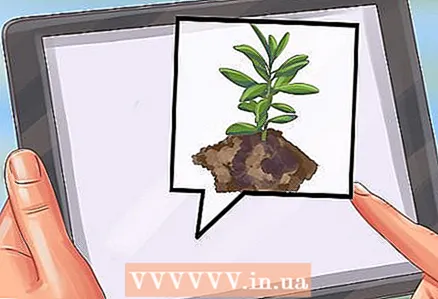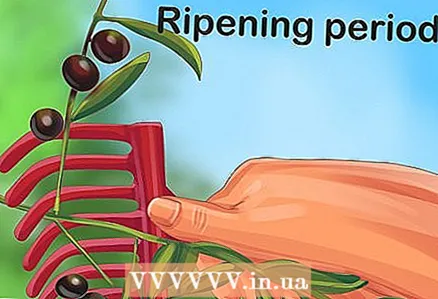Author:
Florence Bailey
Date Of Creation:
23 March 2021
Update Date:
27 June 2024

Content
- Steps
- Method 1 of 3: How to Create the Right Conditions
- Method 2 of 3: How to Plant Olive Trees
- Method 3 of 3: How to care for trees until they are ripe
- Tips
- Warnings
Today olives are grown all over the world for both trade and personal consumption. Although the olive tree can live for over 1000 years, it, like most other plants, requires certain conditions to grow. If you want to grow a mature olive tree from a small sprout and skillfully use the various tricks farmers use to get delicious fruits and oil, read this article.
Steps
Method 1 of 3: How to Create the Right Conditions
 1 Determine if your climate is good for growing olives. Olive trees are best suited for mild winters and long dry summers. For example, olives grow well in the Mediterranean region of Europe and in the coastal valleys of California. At the same time, it is very difficult (if not impossible) to grow olives in tropical climates.
1 Determine if your climate is good for growing olives. Olive trees are best suited for mild winters and long dry summers. For example, olives grow well in the Mediterranean region of Europe and in the coastal valleys of California. At the same time, it is very difficult (if not impossible) to grow olives in tropical climates. - If not taken care of properly, frost can destroy many olive trees. Temperature -5 ºС is harmful for small branches, and at -10 ºС large branches and even whole trees die. Even if the branches and trees survive the cold, the taste of the olives and the oil derived from them may deteriorate. Do not try to grow olives if your region is prone to this kind of frost.
- However, olive trees need a little cold. For the flowers to develop properly, they need to cool down to about 7 ° C, although this temperature is slightly different for different varieties of olives. This is why olives are so difficult to grow in the tropics and other hot climates.
- The flowering season should be fairly dry and moderate. Olives bloom from April to June, and this period should be dry enough and not too hot. Olives are a wind-pollinated plant, so wet conditions can prevent fruit from setting.
 2 Check the soil pH and adjust if necessary. The soil should be mildly acidic to mildly alkaline so that the pH is between 5 and 8.5. Many people think that the ideal pH is 6.5. Check the acidity of the soil with a test kit available at your garden supply store. If the pH is below 5 or above 8.5, change it.
2 Check the soil pH and adjust if necessary. The soil should be mildly acidic to mildly alkaline so that the pH is between 5 and 8.5. Many people think that the ideal pH is 6.5. Check the acidity of the soil with a test kit available at your garden supply store. If the pH is below 5 or above 8.5, change it. - Limestone raises the soil pH, while sulfur lowers it.Limestone and sulfur can be purchased as powder or briquettes at a garden supply store or ordered online.
- Limestone or sulfur can be sprinkled on top of the soil to adjust the pH level of the soil. The exact amount of the substance depends on how much you want to change the acidity. Check the instructions on the packaging. It may take several days before sulfur or limestone is properly absorbed into the soil.
- You can also change the acidity of the soil in a more natural way: raise the pH with peat moss or lower it with pine needles.
- Once you've reached a suitable pH, keep an eye on it throughout the growth process, especially after adding fertilizers that can affect the acidity of the soil. You may need to adjust the pH level periodically as the olive trees grow.
 3 Look for areas with good soil drainage. Check how the water affects the soil in the area where you plan to grow olive trees. Olive trees need land with good drainage. Examine the soil after rain. Do not plant olives where puddles form after rain. You can also dig a hole about 50 centimeters deep in the ground and pour water into it. If the water stays in the hole for a long time and does not absorb into the soil, look for another place.
3 Look for areas with good soil drainage. Check how the water affects the soil in the area where you plan to grow olive trees. Olive trees need land with good drainage. Examine the soil after rain. Do not plant olives where puddles form after rain. You can also dig a hole about 50 centimeters deep in the ground and pour water into it. If the water stays in the hole for a long time and does not absorb into the soil, look for another place. - Drainage problems can be largely solved by planting olive trees on a gentle slope. In this case, water will flow down the slope.
 4 Give preference to the places where olive trees used to grow. This is the best evidence that a particular area is suitable for growing olive trees. If you know that olives used to grow in some place, plant trees there. You can also plant them near already growing olive trees.
4 Give preference to the places where olive trees used to grow. This is the best evidence that a particular area is suitable for growing olive trees. If you know that olives used to grow in some place, plant trees there. You can also plant them near already growing olive trees. - If you are familiar with other gardeners or farmers in your area, ask them if they know where olive trees used to be grown.
 5 Find a place that's in direct sunlight. An area not shaded by other trees is best suited. It should be exposed to direct sunlight for at least 6 hours a day. Shady places are not suitable for olive trees.
5 Find a place that's in direct sunlight. An area not shaded by other trees is best suited. It should be exposed to direct sunlight for at least 6 hours a day. Shady places are not suitable for olive trees.
Method 2 of 3: How to Plant Olive Trees
 1 Plant olive trees in the spring. The main danger for olive trees is frost. As a rule, they should be planted in the spring after warm weather has settled and the danger of night frosts has passed. Olive trees are most commonly planted in April or May, although this varies by region.
1 Plant olive trees in the spring. The main danger for olive trees is frost. As a rule, they should be planted in the spring after warm weather has settled and the danger of night frosts has passed. Olive trees are most commonly planted in April or May, although this varies by region. - The more time the trees have to grow before winter, the better. Try to plant trees as early as possible after the frost hazard has passed.
 2 Start with potted trees. Potted olive trees can be purchased from your local plant nursery or ordered online. Olives have rather delicate seeds that do not germinate well. You will need trees 1.2–1.5 meters high with branches about 1 meter high.
2 Start with potted trees. Potted olive trees can be purchased from your local plant nursery or ordered online. Olives have rather delicate seeds that do not germinate well. You will need trees 1.2–1.5 meters high with branches about 1 meter high.  3 Dig a hole about the same size as the pot. Measure the diameter and height of the pot the tree is in. Dig a hole of about the same depth and diameter. It is not necessary to measure with great precision - the hole should be about the same size as the pot so that the roots of the plant fit well in it.
3 Dig a hole about the same size as the pot. Measure the diameter and height of the pot the tree is in. Dig a hole of about the same depth and diameter. It is not necessary to measure with great precision - the hole should be about the same size as the pot so that the roots of the plant fit well in it.  4 Remove the tree from the pot and examine the roots. Remove the olive tree and roots from the pot. Trim or untangle the braided roots, but do not touch them near the root ball, or you may damage the plant.
4 Remove the tree from the pot and examine the roots. Remove the olive tree and roots from the pot. Trim or untangle the braided roots, but do not touch them near the root ball, or you may damage the plant.  5 Fill up the hole. Use the ground that you got from the hole to fill it. Cover the root ball with a layer of earth 2-3 centimeters thick. You don't need to add fertilizer or compost to the soil at this stage. First, the tree must take root properly in natural soil.
5 Fill up the hole. Use the ground that you got from the hole to fill it. Cover the root ball with a layer of earth 2-3 centimeters thick. You don't need to add fertilizer or compost to the soil at this stage. First, the tree must take root properly in natural soil.  6 Install a drip irrigation device near the tree trunk. Drip irrigation will provide the olive tree with enough water. For the first year, it is necessary to install a drip irrigation device in the immediate vicinity of the trunk of each olive tree. The next year, these devices should be moved away from the trunks at a distance of 60 centimeters. In addition, a second device will need to be added (also at a distance of 60 centimeters from the tree trunk).
6 Install a drip irrigation device near the tree trunk. Drip irrigation will provide the olive tree with enough water. For the first year, it is necessary to install a drip irrigation device in the immediate vicinity of the trunk of each olive tree. The next year, these devices should be moved away from the trunks at a distance of 60 centimeters. In addition, a second device will need to be added (also at a distance of 60 centimeters from the tree trunk). - Installing a drip irrigation device is quite difficult. If you purchase such a device from a store, you will have to tinker with it to install it yourself, unless you have a lot of experience in gardening, so it is better to resort to the services of a specialist.
- Typically, drip irrigation devices are connected to a water source, such as an external water tap. You can run a hose from the source to the trees. After that, holes should be made in the hose and devices installed in them so that the water irrigates the olive trees.
 7 Water the trees and mulch the soil with straw. Water olive trees with drip irrigation devices.
7 Water the trees and mulch the soil with straw. Water olive trees with drip irrigation devices. - Instead of coarse straw, you can use a different material for mulching. For example, mulch made from alfalfa, soybeans or pea hay is rich in nitrogen and other essential nutrients for trees.
Method 3 of 3: How to care for trees until they are ripe
 1 Water and water olive trees sparingly and as needed. With a drip irrigation system, trees should be watered every day during the summer. Water the olive trees for an hour. You can also use small sprinklers (spray guns), which should be installed at least 60 centimeters from the tree trunk. Find sprinklers with a water flow rate of 2.5-5 millimeters per hour and install them between the trunks of the olive trees.
1 Water and water olive trees sparingly and as needed. With a drip irrigation system, trees should be watered every day during the summer. Water the olive trees for an hour. You can also use small sprinklers (spray guns), which should be installed at least 60 centimeters from the tree trunk. Find sprinklers with a water flow rate of 2.5-5 millimeters per hour and install them between the trunks of the olive trees. - The frequency of watering depends on whether you are going to use the fruit or make oil from it. If you are growing fruit, water the trees more often — about once a week or every 2-3 weeks. If you are going to make oil, water the trees less often to make it more concentrated and aromatic.
 2 Prune trees regularly. Don't prune young trees too often. For the first four years, simply remove the side branches that grow below 1 meter. As the trees grow, they will take on the proper shape, and you can cut off weak and unwanted branches. However, try to prune the trees as little as possible in the early stages, as this can slow down their growth.
2 Prune trees regularly. Don't prune young trees too often. For the first four years, simply remove the side branches that grow below 1 meter. As the trees grow, they will take on the proper shape, and you can cut off weak and unwanted branches. However, try to prune the trees as little as possible in the early stages, as this can slow down their growth.  3 Fight pests and other diseases. Like most other plants, olive trees are sometimes attacked by pests, especially the oleifera (Saissetia oleae). If you are growing olives, you need to find a balance between natural methods and effective plant protection against pests and diseases. Sometimes trees have to be treated with insecticides. It is best to consult a professional about this.
3 Fight pests and other diseases. Like most other plants, olive trees are sometimes attacked by pests, especially the oleifera (Saissetia oleae). If you are growing olives, you need to find a balance between natural methods and effective plant protection against pests and diseases. Sometimes trees have to be treated with insecticides. It is best to consult a professional about this. - The oleaginous false shield leads to the formation of small areas on the surface of the bark, covered with black growths. These growths can grow rapidly as the pest multiplies. Although the oleaginous scabbard usually infects diseased plants, healthy olive trees are not immune to its attack. If you find this disease, treat the trees with an appropriate insecticide.
- Olive trees can also be affected by verticillium wilt, in which leaves and branches drop and wither. There is no cure for this fungal disease, although some varieties of olives are immune to it. If the infected branches are not pruned, the disease can affect the entire tree. When infested with verticillium wilt, even very young trees can be pruned. If you have experienced this condition before, do not plant olive trees in the same area.
 4 Use fertilizer in moderation. Typically, olive trees need adequate soil and adequate watering.However, you can stimulate their growth by adding a little fertilizer. Choose a fairly mild fertilizer and sprinkle it lightly on the soil during the growing season. The package should indicate the appropriate dosage and when and how the fertilizer should be applied (usually applied over the soil). When in doubt about the exact dosage, go for a smaller amount.
4 Use fertilizer in moderation. Typically, olive trees need adequate soil and adequate watering.However, you can stimulate their growth by adding a little fertilizer. Choose a fairly mild fertilizer and sprinkle it lightly on the soil during the growing season. The package should indicate the appropriate dosage and when and how the fertilizer should be applied (usually applied over the soil). When in doubt about the exact dosage, go for a smaller amount. - The fertilizer package contains the ratio of the nutrients it contains, such as nitrogen. Fertilizers work well for olive trees at 10:10:10 or 13:13:13.
 5 Wait a few years before the trees begin to bear fruit. Under normal watering, olive trees give their first harvest 2-3 times faster than in dry conditions. With proper care, some are able to harvest their first crop 2-3 years after planting, although many olive trees do not bear fruit until 10 years. Remember that growing olives takes a long time. Two years after planting the trees, start checking for fruit, but remember that they may start bearing fruit much later.
5 Wait a few years before the trees begin to bear fruit. Under normal watering, olive trees give their first harvest 2-3 times faster than in dry conditions. With proper care, some are able to harvest their first crop 2-3 years after planting, although many olive trees do not bear fruit until 10 years. Remember that growing olives takes a long time. Two years after planting the trees, start checking for fruit, but remember that they may start bearing fruit much later.  6 Decide when to harvest. Green olives appear first and turn black as they ripen. When picked, green olives will have a pungent and herbaceous flavor, while ripe olives will have a softer, buttery flavor. Often the oil is made from a mixture of green and ripe olives, which are harvested just as they change color. Determine which type of oil is right for you and wait for the olives to turn the color you want before picking them.
6 Decide when to harvest. Green olives appear first and turn black as they ripen. When picked, green olives will have a pungent and herbaceous flavor, while ripe olives will have a softer, buttery flavor. Often the oil is made from a mixture of green and ripe olives, which are harvested just as they change color. Determine which type of oil is right for you and wait for the olives to turn the color you want before picking them. - Remember, olives are not eaten raw, straight from the tree. As a rule, before use, they must be treated with brine, that is, soaked in salt water.
Tips
- The olive tree can be grown indoors in a large enough pot.
- Olive trees can grow up to 15 meters high and their crown can extend up to about 9 meters wide.
- An olive tree can be planted on a slope or on a terrace, but it can be more difficult to care for and harvest.
- To prevent fruit from sprouting in unwanted areas, prune appropriate flowering branches in early summer.
Warnings
- Use a clean tool when pruning olive trees during the rainy season, or bacteria may build up growths on them due to bacterial contamination.
- Olive trees grown in California can be infected with the fungal disease "verticillium wilt". Remove diseased trees and branches and do not plant trees in infected areas.
- In the Mediterranean region, olive trees can be attacked by pests such as the Mediterranean fruit fly and the olive tree fly.
- If you are going to make olive oil, try not to spray the trees with chemicals, as they can give the oil an unpleasant odor.
- Ripe olives tend to soften, so pick carefully.



